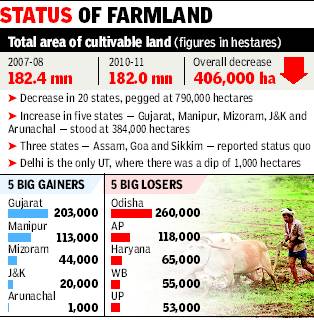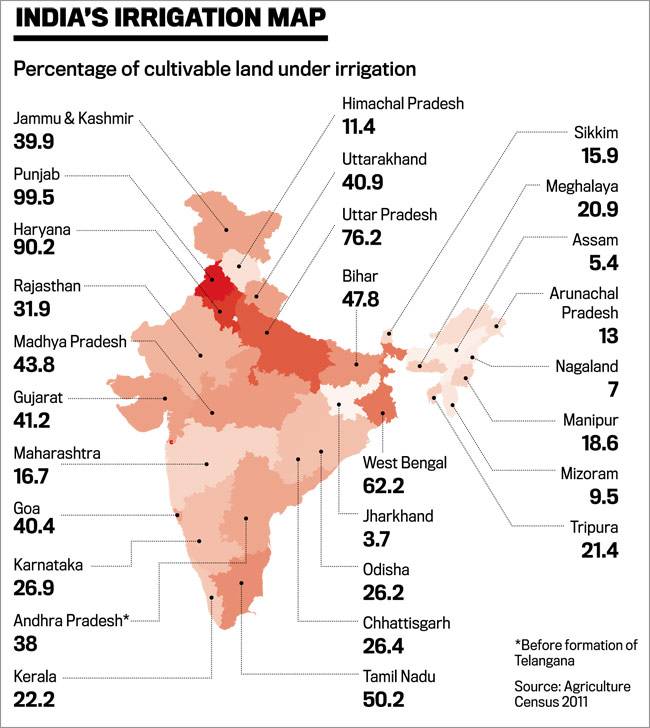Agriculture: India
This is a collection of articles archived for the excellence of their content. Readers will be able to edit existing articles and post new articles directly |
An overview
1951-2020
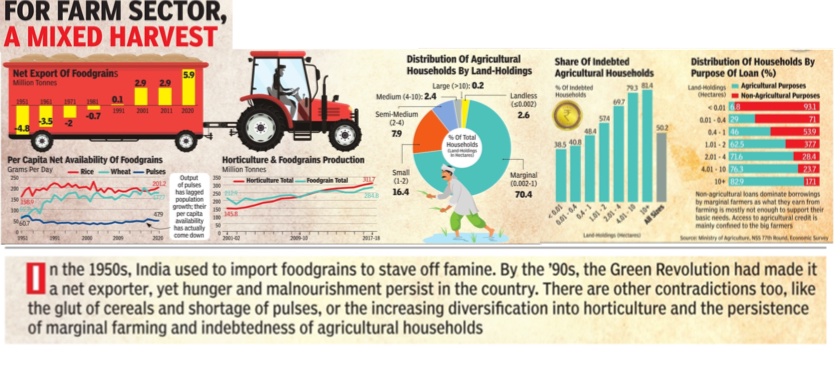
Horticulture, food grain production and export/ import
Indebtedness among agricultural households
Agricultural loans
From: February 2, 2022: The Times of India
See graphic:
Agriculture in India, An overview, 1951-2020
Horticulture, food grain production and export/ import
Indebtedness among agricultural households
Agricultural loans
Cultivable land
India has the largest cropland in the world
November 19, 2017: The Times of India
India, rather than the US or China, has the biggest acreage of agricultural land in the world. Global cropland totals 1.87 billion hectares (4.62 billion acres), more than 15% higher than earlier estimates, according to a map released by the US Geological Survey. India has the largest cropland of any country at 179.8 million hectares, compared with 167.8 million in the US and 165.2 million in China.
Cultivable land continues to shrink
Cultivable land continues to shrink
Vishwa Mohan TNN
New Delhi: Cultivable land in India continues to shrink. It may not pose an immediate problem for the nation’s food security but its long-term effect could be disastrous with the country needing more and more foodgrains to support its growing population.
Latest data from the agriculture ministry shows that as many as 20 states reported decrease in cultivable land to the extent of 790,000 hectares in four years from 2007-08 to 2010-11. The decrease is mainly attributed to diversion of cultivable land for non-agricultural purposes, including construction, industries and other development activities.
Since such diversion is inevitable, the government had in its National Rehabilitation and Resettlement Policy (NRRP), 2007 recommended several measures to keep a tab on ever-decreasing cultivable land in the country.
But the data, shared by the agriculture ministry in response to a question in the Lok Sabha on Tuesday, shows that only five states have taken some steps to increase the areas under cultivation and three others (Assam, Goa and Sikkim) have adhered to the policy of not tinkering with land which can be used for farming.
Gujarat is the only big state which increased the area of cultivable land during four years from 2007-08 to 2010-11. Manipur, Mizoram, Jammu & Kashmir and Arunachal Pradesh are the other states which reported increase.
Haryana showed the sharpest decline in area under cultivation. The small state reported decrease of 65,000 hectares of agricultural land between 2007-08 and 2010-11.
Since land falls under the purview of states as per the seventh Schedule of the Constitution, it is for states to bring in suitable policy to prevent diversion of agricultural land for non-agricultural purposes. The Centre had under its 2007 policy advised states to allow development projects to come up on wastelands.
Under NRRP, states were advised that acquisition of agricultural land for nonagricultural use should be kept to the minimum, multicropped land should be avoided to the extent possible for such purposes and acquisition of irrigated land, if unavoidable, may be kept to the minimum.
But it seems most states have not followed the norms, leading to overall decrease of nearly 406,000 hectares of cultivable land in the country during the four-year period.
Under Irrigation
Ajit Kumar Jha , Irrigation map “India Today” 12/6/2017
See graphic
Exotic fruits/ vegetables cultivation
2022/ Kerala
K A Martin, Oct 9, 2022: The Hindu
Tryst with exotic fruit continues in Kerala’s farms
Kerala farmers continue their tryst with the exotic and more farmlands are finding space for new imports that include bitter melons or wild bitter gourds from North Eastern States of India, butternut squash from Central America and gac fruit from Vietnam and its neighbours. Along with these exotics, interest is being revived in the cultivation of loquat from China, which used to be cultivated by some farmers in soil rich in clay in some parts of the State.
Gone are the days when dragon fruits and rambutan and musk melon used to be in vogue. V.R. Shine, a farmer, says that wild bitter gourd is in great demand and fetches up to ₹100 a kg. He has been a farmer throughout. Farming activities have intensified after he returned from the Gulf. He is 68 and continues to cultivate a variety of crops and recently he was introduced to the wild variety of bitter gourd by a worker from Assam, who taught him the basics of cultivating the vegetable.
Hailing from near Karumaloor, Mr. Shine says that the shop owners, who have been selling the produce for much higher price than his own sale price have been demanding more supplies though the recent dry spell has resulted in a halt in production.
Butternut squash is a great substitute for our own traditional pumpkin and can take the place of the old pumpkin in any of the preparations including for making ‘payasam’, a desert that goes with a full meal in the State.
K. M. Sebastian, a stone mason from near Kottuvalli, does farming as a mean of earning some extra income. In fact, he cultivates around 24 varieties of local vegetables including snake and ridged gourds, okra and vegetable cowpea on about 20 acres of leased land.
He said butternut squash has been in great demand in the market, which can be used to make shakes. It is sweet when ripe and can be eaten like papayas though the flesh is more dense. It can also be used as a great raw material for making jams and squash, he added.
The small vegetable and fruit garden developed at his home by Karukunnil Ashokan from Karumaloor panchayat is dominated by gac fruit from Vietnam. Gac fruit, said an official of the Department of Agriculture is some times described as the Fruit of Heaven. Mr. Ashokan is now interested in producing saplings of gac fruits and spreading the cultivation.
Fertilisers: India
Gross value of output (GVO) of various crops: ‘group’-wise
2011-23
Vishwa Mohan, June 22, 2024: The Times of India
New Delhi : In what could be asign of growing preference of Indian consumers, ‘fruits and vegetables’ with 28% share occupied the top position in the group of all crops in value terms in 2022-23, higher than the share of cereals (27%), shows a new statistical report.
The report on the value of output from agriculture and allied sectors shows the output of ‘fruits and vegetables’ has increased from Rs 2,87,000 crore in 2011-12 to Rs 4,34,000 crore in 2022-23 at constant (2011-12) prices, about Rs 15,000 crore higher than that of cere- als even as they constantly occupy much more acreage than the horticultural produce.
Besides ‘cereals’ and ‘fruits & vegetables’, the other segments of the cropgroup include pulses, oilseeds, sugarcane, spices and medicinal plants among others occupying the remaining 45% share in terms of value.
Among the overall agriculture and allied sector, the crop-group occupies 54% share followed by livestock (31%), forestry (8%) and fishing (7%) in value of output in 2022-23. Though the crop subsector remains the largest contributor of gross value of output (GVO) of the agriculture and allied sectors, its contribution has gradually declined from 62% in 2011-12 to 54% in 2022-23.
According to the report, brought out by National Statistical Office (NSO), Uttar Pradesh reported the highest value of output of cereals whereas highest value of output of fruits and vegetables was in West Bengal in 2022-23.
The report also shows that Gram and Arhar (lentil) together accounted for nearly 59% of the output of ‘pulses’ group of crops.
2011> 2023
GVO from the agriculture and allied sector at constant prices has shown steady growth from Rs 19 lakh crore in 2011-12 to Rs 29 lakh crore in 2023-24, an increase of nearly 54.6%.
Growth
Growth rate of agriculture/ 2015-16
Ajit Kumar Jha , Growth rate of agriculture 2015-16 No country for farmers “India Today” 12/6/2017
See graphic Growth rate of agriculture 2015-16
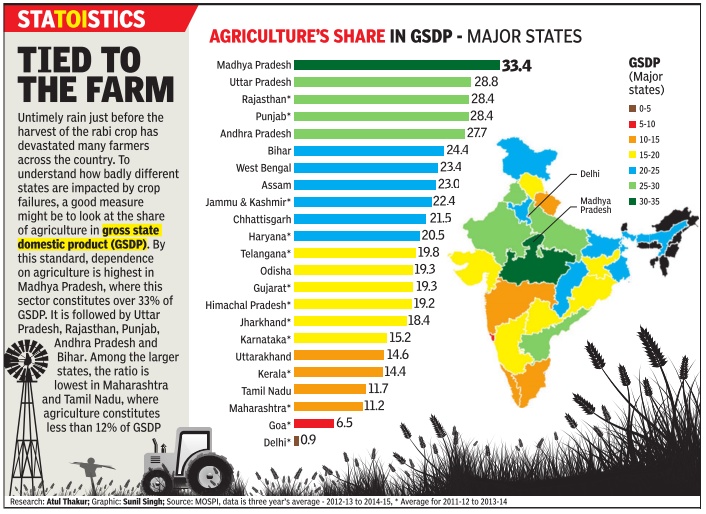
See graphic 'Share of agriculture in GSDP, state-wise'
Harvests, yield (foodgrains, pulses)
Cereal yield
Agricultural yields, 1961-2017: India, China, others

From: July 30, 2019: The Times of India
See graphic:
1961-2017: Agricultural yields in India, Australia, Brazil, China, Germany, USA.
2011-16: Profitability in cultivation, a decline
Subodh Varma, For farmers, grass is greener than wheat & rice , June 25, 2017: The Times of India
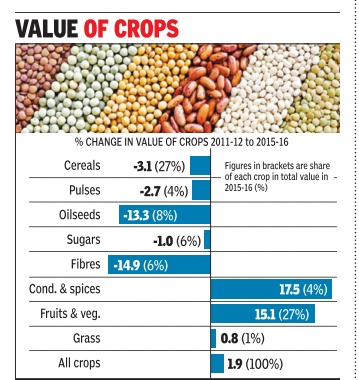
Growing grass and selling it in the market may be more profitable than cultivating crops such as wheat, rice, pulses and oilseeds.This bizarre conclusion, a reflection of the desperate conditions of Indian farmers, can be reached if one looks at how the value of various crops has changed.
Between 2011-12 and 201516, the total value of cereals and pulses produced in the country went down by about 3%, oilseeds by over 13% and sugars by 1%. But value of grass, which is mainly used as cheap forage for milch animals, increased by about 1%. Output values zoomed up for two types of food items -fruits and vegetables by over 15% and condiments and spices by nearly 18%. This information is derived from the latest National Accounts Statistics 2017 released by the Central Statistics Office. It is this declining output value, which is at the root of farmers' sorrow and an ger, finding expression in a range of ways from suicides to agitations demanding loan waivers or even job reservations for specific communities. Output values are declining because the cost of what the farmers put in -seeds, fertilisers, water etc. is rising faster than the prices they get by selling their produce.
Nearly a third of the total value of agricultural production in India was contributed by cereals and the same by fruits and vegetables, up from about 24% five years ago. Many of the estimates of output value, which is obtained by multiplying total production of a crop by prevailing prices for that crop, are broad guesses, says Vikas Rawal, associate professor of economics at JNU. He especially flagged fruits and vegetables estimates at being sketchy and growth rate seeming to be higher because of starting off from a lower base.
“But, even then, the data does show that most farmers, involved in food grain production, are not getting good returns for their investment and labour,“ he told TOI. Fruits and vegetables have emerged as a much more attractive investment for farmers because of a mix of several reasons. With nearly half of the cultivated land in India under small and marginal holdings of less than two hectares, it has become increasingly difficult for farmers to manage the longer duration and more demanding crops like cereals, pulses and oilseeds.Vegetables offer the big advantage of needing much less fertilizers or pesticides, and they can grow up and be ready for cash sale within 2-4 months. With prices of pulses sky-rocketing, demand for vegetables too has shot up. Better transport facilities and road connectivity eases marketing. But everybody can't start growing only vegetables and fruits. Besides not paying enough, their marketing is subject to many risks including sharp price fluctuations and perishability .Food grains can provide much more security and larger incomes provided prices are good. And, the govt. too provides some support through various subsidies and procurement. Ultimately, the whole country survives on the food grains produced by farmers.
2015: Poor rainfall but kharif sown area rises 12 lakh ha

The Times of India, Sep 25 2015
Despite rainfall deficit, kharif sown area rises by 12 lakh ha Rise in areas under pulses and oilseeds
In what could be an indication of higher foodgrain production, the country this year recorded an increase of nearly 12 lakh hectares in total kharif sown area as on Thursday compared to the corresponding period last year, despite almost similar amount of rainfall deficit during June-September monsoon season. The agriculture ministry figures on kharif sown area show that the total area under summer crops reached 1026.23 lakh hectares as com pared to 1014.24 lakh hectares ast year at this time.
Except cotton and jute, sown area under other major crops, including pulses and oilseeds, increased this year as compared to 2014 reflect ng the positive impact of con ingency measures taken by he government, based on ad vance input of deficit rainfall rom the IMD. Such measures helped farmers in different ways to ensure sowing operation after late revival of monsoon in certain regions.
In fact, sown areas under pulses, oilseeds, sugarcane and cotton are more than normal' sown area of these crops. `Normal' sown area is calculated as an average of sown area of a particular crop in last five years.Though the area under cotton (115.20 lakh hectares) is less than last year (125.75 lakh hectares), it is still higher than its normal sown area (115.02 lakh hectares).
The country has so far reported 12% rainfall deficit, however, this figure will slightly change once IMD comes out with its final report covering June-September period.
Though the initial report estimates slightly less foodgrain production this year as compared to last year, the in crease in sown area shows sign of improvement with some regions witnessing late start of sowing operation.
According to data, the sown area under rice was 374 lakh hectares as compared to 373 lakh hectares last year.While sown area under pulses stand at 113.45 lakh hectares as compared to 101.83 lakh hectares last year, the area under oilseeds reached 183.68 lakh hectares as compared to 177.49 lakh hectares in 2014.
Though the government's first `advance estimate' put the total kharif foodgrain production for the year 2015-16 at 124.05 million tonnes (MT), which is 2.26 MT less than the `actual' kharif output of 201415, it is expected the output would eventually increase backed by higher sown areas under different crops.
2016-17: Good monsoon
Backed by welldistributed monsoon rains this year, India is expected to register a record foodgrain production during the 201617 crop year (July-June). The government has already set a target of 270.10 million tonnes of yield for the year -surpassing its previous record of 265.04 million tonnes in 2013-14.
Though the current year has reported 5% of deficit rainfall so far, adequate rains in July and August, especially in water stressed areas, where it was needed during peak sowing season, has sent positive signals.
Rainfall this year got the water level in major reservoirs up to satisfactory levels as compared to two consecutive drought years of 2015 and 2014 when the country had reported 14% and 12% of deficit rains respectively. This along with good soil moisture condition has signalled the possibility of better rabi season in terms of acreage, making the prospect of achieving the target of record foodgrain production brighter.
“Overall, monsoon has been favourable for farmers this year. We have received good rains and distribution was also good. I am sure, we will have record production this year,“ Union agriculture minister Radha Mohan Singh said while addressing a conference on rabi crops.
The government has a target of 20.75 million tonnes (MT) for pulse production during 2016-17 which includes 13.50MT of pulses output from the rabi season.
Urging states to promote pulses even in the rabi season beginning October, Singh said, “States should prepare work plans for more coverage of rabi pulses and oilseeds in rain-fed areas.“
2017-18: Higher sown area under Rabi
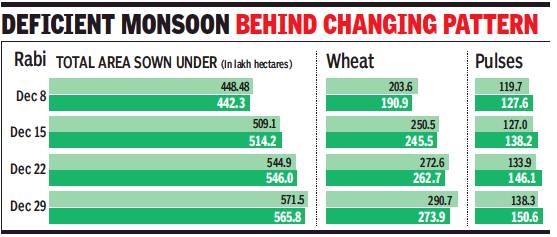
From: Vishwa Mohan, Overall rabi sown area dips, but pulses’ on rise, December 30, 2017: The Times of India
Hike In MSP Pushes Farmers To Diversify Crop Pattern
After recording marginally higher sown area under Rabi crops for the past two weeks this month as compared to the corresponding period last year, the overall sown area dipped again on Friday.
But farmers’ choice to bring more area under pulses kept hopes alive for a good farm production during 2017-18 crop year (July-June).
Though the overall dip is attributed to sharp decline in area under wheat, the 9% rise in sown area under pulses so far (from 138.34 lakh hectares in 2016-17 to 150.63 lakh hectares this year) has kept the gap less.
The sown area data, released by the agriculture ministry, show that the total area under rabi crops as on Friday stand at 565.79 lakh hectares as compared to 571.47 lakh hectares at this time last year.
“Deficient monsoon rainfall in wheat growing Uttar Pradesh and Madhya Pradesh resulted in less soil moisture and therefore the farmers in these two states and elsewhere opted not to go for bigger areas under wheat. Instead, they opted for pulses which use less water from deep soil,” said an official.
He said the larger area under pulses has indicated that the farmers have also diversified their cropping pattern a bit, keeping in view the increase in minimum support prices (MSP) for the 2017-18 crop year.
The government had in October increased MSP of six Rabi crops. Though the MSP of wheat was also increased (by 6.8%), the hike was higher for pulses. The MSP of gram was increased from Rs 4,000 per quintal last year to Rs 4,400 per quintal in 2017-18— a hike 10% per quintal.
Officials, tracking the sowing operations, believe that the marginal dip in overall sown area under Rabi crops is not a sign of worry as farmers still have three-four weeks of sowing operation left for different crops.
2019
Fall in production of food grains, coarse cereals

Cotton production, 2017-18
From: Fall in production of foodgrains, coarse cereals to drag down agriculture harvest in FY19, February 4, 2019: The Times of India
After a bumper season in the previous year, agricultural production is expected to decline in 2018-19. This will be driven by a fall in production of pulses and coarse cereals. Production of foodgrains, coarse cereals and pulses hit a record high in 2017-18. The fall in 2018-19 is due to a disappointing kharif season when production of all major crops is estimated to have declined. The rabi season is also expected to be unsatisfactory. Here's a look.
Rabi, 2019-20
Amit Bhattacharya, January 29, 2020: The Times of India

From: Amit Bhattacharya, January 29, 2020: The Times of India
NEW DELHI: In what could help raise rural demand amid an economic slowdown, conditions are favourable for a bumper rabi (winter) crop this year, with wheat output likely to touch a record high at 10% more than last year, an estimate released by private weather forecaster Skymet said.
Skymet said good postmonsoon and winter rainfall, sustained cold conditions in the north and a higher support price for wheat were major positive factors for higher production this year. The agency predicts wheat production to touch 113 million tonnes (MT) in the rabi season of 2019-20, 10.6% higher than the 102.2 MT produced last year.
Bengal gram production is expected to go up by 5%, mainly on count of higher acreage this season, while rapeseed and mustard production is likely to see a marginal improvement of 1.4%, Skymet said. According to agriculture ministry data, as on January 24, the area under wheat cultivation was 10.6% higher than the same period last year and 9.6% above the 10-year average. A total of 654.1 lakh hectares had been sown against 597.5 lakh hectares sown at the corresponding period last January.
Three states reported a sharp jump in the sown area for wheat. In Maharashtra, the area under wheat rose by 80.1%, while Gujarat reported a 72.2% rise and Madhya Pradesh a 32.8% jump. Area under wheat dropped slightly in Bihar by 3.5%.
Overall, the net area under rabi crops has grown by 8.7% over last year. Lesser crops such as rabi rice also reported a 23.5% increase in sown area followed by coarse cereals (16.5% increase) and pulses (5.7%). Expectations from the rabi season have been high ever since the country experienced 10% higher monsoon rainfall.
The bountiful rainfall and delayed monsoon retreat led to floods in many places, which hit the kharif (summer) crop but laid the ground for a good winter crop.
2020/ rabi

From: June 13, 2020: The Times of India
See graphic:
Agricultural production in India during the 2020 pandemic, till early June.
2020: bumper growth amidst Covid
Vishwa Mohan & Dipak Dash, May 29, 2020: The Times of India

From: Vishwa Mohan & Dipak Dash, May 29, 2020: The Times of India
When economic activity ground to a halt in cities amid the nationwide lockdown, much of the countryside kept its date with the farm calendar. Exemption from restrictions allowed farmers to harvest and transport foodgrains to mandis while the Food Corporation of India (FCI) and the states carried out massive procurement in an extraordinary situation.
In the first lockdown, which coincided with the peak harvest operations of Rabi crops (wheat, mustard and pulses), the home ministry allowed harvesting, threshing, sowing, procurement and other related activities with riders for social distancing, hand hygiene and use of face covering. After some glitches, farm operations picked up from the second week, raising hopes that the crisis would spare the rural economy, which supports a little over half of the population. “Initial indications are positive for normal growth in the agriculture sector. However, agricultural output is subject to the vagaries of nature till the end of the year,” Niti Aayog member Ramesh Chand told.
Sowing is now on for premonsoon summer crops like paddy, pulses, coarse cereals and oil seeds, and it’s all good news so far. On May 22, the sown area was 34% higher than on the same date last year. This could be because of more water in reservoirs and higher pre-monsoon rainfall (March-May).
“The lockdown has affected all sectors adversely, but not agriculture so much because of the normal Rabi season and farmers’ ability to adjust to adversities,” said Suresh Pal, director of the National Institute of Agricultural Economics and Policy Research (NIAP). A normal monsoon would further shield the rural economy from income shocks.
IMD’s forecast of a normal monsoon has laid the ground for timely sowing. Increase in sale of fertilisers also suggests farmers are preparing in advance for the main Kharif sowing, beginning June. While the producers of perishables, such as milk, poultry, fish, vegetables and flowers, took a hit in the early days of the lockdown, subsequent easing for all farm and market operations have helped them too. But there is concern over the drop in sale of vegetable seeds during the lockdown.
“The government has been helpful, but the final impact of the crisis can only be gauged once the Kharif season sales close,” said Indra Shekhar Singh, director, policy and outreach, National Seed Association of India (NSAI), which represents the seed industry. He said seed sales could fall by 20-30% if farmers run out of credit. “While big firms are hurt, many small and medium ones that are working on credit may have to shut shop.”
Pal, however, said the the government’s package for agriculture and market reforms will be beneficial. “Government support and policy reforms should be used for establishing more compact and efficient supply chains and attracting the business sector in agriculture.” States could also carry out reforms at the local level to allow farmers to sell their produce outside registered mandis. Many have allowed Farmer Producer Organisations (FPO) to deliver horticultural produce directly from farm to fork.
Besides, decisions to allow 13 states to buy gram and lentils under a price support scheme (PSS), stagger the procurement of wheat, and direct Nafed to procure mustard will aid farmers. Nafed has already procured over 7 lakh tonnes (LT) of gram, nearly 6 LT of mustard and 2.4 LT of lentils in the lockdown. All these market-related measures collectively could ensure smooth farm operations in most of the states.
Growth, crop-wise

From: March 16, 2021: The Times of India
See graphic:
Agricultural growth in India, crop-wise, in 2020
Horticulture production
See: Horticulture: India
Organic farming in India
2010-14, lack of financial support to organic farms
The government under a national programme promotes organic farming, ongoing projects and financial outlays that had gone into the process in the past four years does not appear to be enough to match the rising demand of chemical fertilizer-free and pesticide-free food products.
Organic farming involves an ecological production management system that promotes and enhances biodiversity, biological cycles and soil biological activity in a sustainable manner. Farmers do not use chemical fertilizer and pesticides in such farm practices.
Although the government has devised a number of plans to promote organic farming in the country, the extent of financial support under a national programme is quite less. It was just Rs 129.91 crore in 2010-11 under the Rashtriya Krishi Vikas Yojna (RKVY) - a key national programme - to promote organic farming. Though the amount was increased for the purpose to Rs 311.31 crore in 2011-12, it fell down to Rs 143.81 crore in 2013-14. The amount is quite less if one compares it with the total amount (Rs 9968.72 crore in 2013-14) allocated by the Centre to the RKVY for overall promotion of agriculture.
Financial assistance is provided through state governments for organic village adoption for manure management and biological nitrogen harvesting, promotion of organic input production on farmer's field and promotion of certification for area under organic farming for export purposes.
Aquaponic farm/ Gurugram, 2017
GURUGRAM: There is a huge demand for organic farming in the country right now specially after reports of high level of chemicals and toxic in the vegetables being sold in the markets. Many urban dwellers have even taken up kitchen gardening which however, is often restricted due to want of space.
Gurugram based Sushant Madaan is one such organic farming enthusiast who has set up a first of its kind aquaponic farm in Northern India. Aquaponics, a technique that marries horticulture and aquaculture helps the farmer raise fishes while he also grows plants.
"In aquaponics we grow fish and plants together in a tank. The tank has fishes in it and on the sides of the tank there are beds for plants. The water from the fish tank which is rich in nutrients due to the fish waste goes into the plants," said Madaan.
The beds for supporting the plants can be made using material such as thermocol sheets or gravel. Madaan setup the farm in June this year and will be growing only leafy vegetables for this season.
He has done a Master of Science in Sustainable energy systems from Netherlands and Sweden and has been exploring different organic farming techniques for a while. Madaan says that not only aquaponics is a great way to get organic produce but it is also gaining popularity among urban farmers who are trying it as a hobby. This technique of agriculture is an organic farming technique as there is no use of any fertilisers plus it.
District horticulture officer who has been tracking the project said, "It is the first of its kind aquaponic project in Northern India and is a great technique especially with the ever increasing demand of organic fruits and vegetables in the urban areas," said Deen Mohammad Khan. Khan added that the technique which is currently new in India is very widely used in countries like Japan and China. According to Madaan, the cost of setting up an aquaponics farm ranges between Rs. 5 lakhs to Rs. 15 lakhs. While the setup cost of aquaponic farm might be higher than conventional farms, but the operational cost is much less as there is no need for fertilizers and the water requirement is 90% less than that required in conventional farming. Also the yield from aquaponics is two times higher than that of conventional farming. However, one restriction being that fruits and vegetables which grow underground cannot be grown using aquaponics.
Production: what India grows
2012-18

From: September 4, 2018: The Times of India
See graphic:
Production of foodgrains, vegetables and fruits in India, 2012-18
2007-18: Crop output

From: January 26, 2019: The Times of India
See graphic:
2007-18: Crop output in India
Sector – wise growth
The best performing sectors 1961, 1971, 2010, 2024
Vishwa Mohan, February 28, 2024: The Times of India
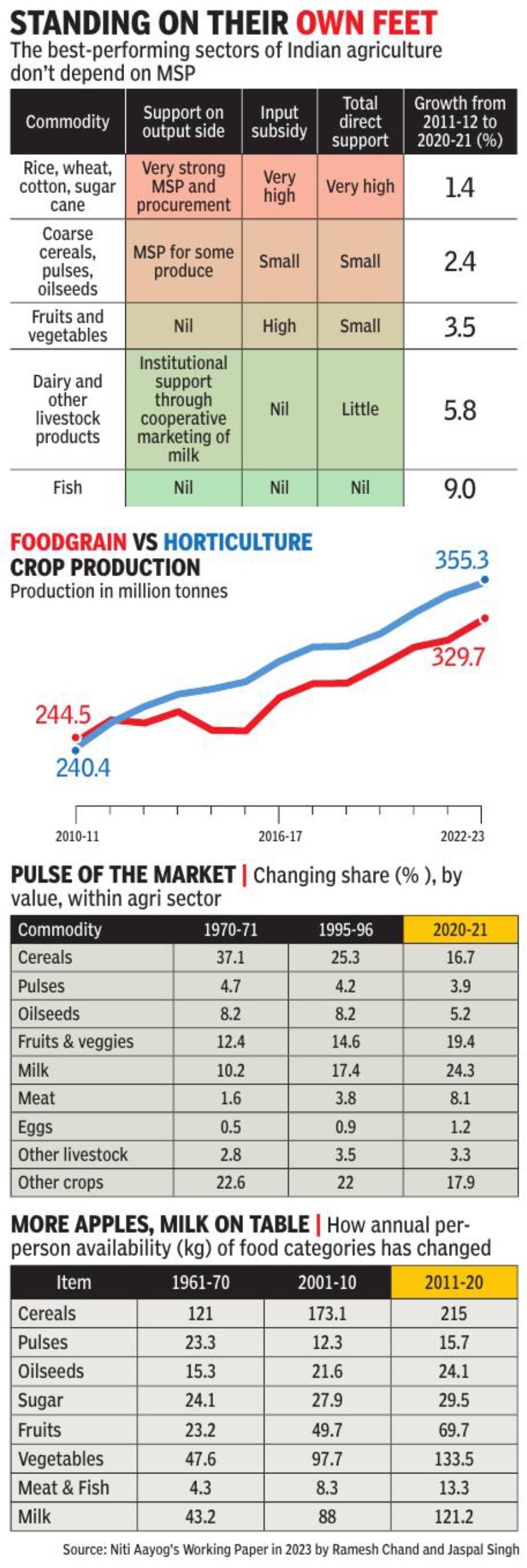
From: Vishwa Mohan, February 28, 2024: The Times of India
Farmers are at the barricades again over the issue of minimum support price (MSP), but production data shows they might be better off diversifying into dairy and horticulture.
Between 2011-12 and 2020-21, horticulture (fruits, vegetables, spices, flowers and plantation) showed 3.5% annual growth without govt’s price intervention (like MSP), whereas crops with strong support – paddy (rice), wheat, sugar cane and cotton – averaged 1.4% annual growth. “It shows demand-driven factors can be much stronger than govt price support in pushing growth and farmers’ income,” Ramesh Chand, Niti Aayog member and one of India’s top agricultural economists, told TOI.
Chand said this has happened because people in India and abroad are choosing to consume more fruits and vegetables, meat, milk and fish, “offering producers a more remunerative environment to raise production”.
The trend can be traced all the way back to the 1960s, since when per-person availability of cereals has not even doubled, but that of fruits and vegetables has almost trebled. A joint working paper by Chand and his colleague Jaspal Singh also shows that perperson availability of oilseeds increased by less than 60% in these 60 years, and that of pulses is actually 33% lower now. Also, the share of cereals in Indian agriculture, by value, has fallen from more than a third in the 1970s to about one-sixth now, while that of horticulture has risen from about one-eighth to one-fifth. Eggs are another remarkable success story, with an eight-fold increase since the 1960s, without any govt price intervention. “These changes show a clear shift in the composition of food output in favour of horticultural and livestock commodities,” said Chand.
Data clearly shows significant diversification in food production and consumption after 1981. For example, livestock products made up 17.6% of total agri output, by value, in 1980-81. This rose to 27.4% in 2001, and 36.9% in 2021.
So, should farmers switch over to horticultural crops from cereals? Agricultural scientists say they should, for not only better incomes but also India’s nutritional security and to prevent soil and water depletion.
Price support for two water-intensive crops – paddy and sugar cane – is indirectly taking a toll on India’s water resources. Govt offers MSP for paddy and ‘fair and remunerative price’ for sugar cane. This encourages farmers even in the drier regions to grow them with groundwater. While India earns forex through rice and sugar exports, it doesn’t compensate for the lost water resources.
“Horticulture provides an opportunity for crop diversification and intensification for adequate nutritious food, and augmenting farmers’ incomes,” Anand Kumar Singh, vice-chancellor, Chandra Shekhar Azad University of Agriculture & Technology, Kanpur, and former deputy director general, ICAR (horticultural science), told TOI. He said there are many success stories of farmers who have started growing highvalue fruits like avocado and dragon fruit.
Besides, horticulture scores over cereals in terms of productivity also. Where the average grain yield is 2.2 tonnes/hectare, that of horticulture crops is 5.6 times higher at 12.5 tonnes/ha.
Soil, nutrient deficiency in
The problem, as in 2019, briefly
Nutrient deficiency in soil poses maximum challenge to agricultural productivity and land parcels in a majority of states and soil in Maharashtra, in particular, face deficiency of as many as five nutrients, the government has told Lok Sabha.
According to a written reply by agriculture minister Narendra Singh Tomar, soil in a dozen states including Andhra Pradesh, Chhattisgarh, Gujarat, Madhya Pradesh, Uttar Pradesh and Telangana face nitrogen deficiency while phosphorus deficiency has been found in 14 states, which include Assam, Haryana, Delhi, Puducherry, Uttar Pradesh, Odisha and Goa. Potassium deficiency in soil has been found in six states (five of them in northeast) and these include Assam, Arunachal Pradesh, Meghalaya, Tripura and Andaman and Nicobar Islands.
Nitrogen, phosphorus and potassium, known as NPK, are essential for plant growth.
The government carried out a nationwide assessment of deficiency of eight nutrients in soil, which adversely impact fertility. The data showed that agricultural land in Maharashtra had deficiency of nitrogen, iron, zinc, sulphur and boron. Similarly, the soil test in Gujarat found deficiency of nitrogen, zinc and boron.
The government also said there were 7,949 soil testing labs in the country including 1,293 static labs, 165 mobile labs, 6,337 mini labs and 154 village level labs.
Quinoa and other S. American seeds
The Times of India, Apr 11 2016
S. America seeds give rich dividends in UP
Arindam Ghosh After giving half a century to farming of pulses and wheat, with depleting yield due to drought or erratic rains, 62-year-old Jagmohan Rajpoot of Rigwara Khurd village in Hamirpur can look forward to a new lease of life -in cultivation of quinoa, a cash crop native to South America that requires minimal irrigation and fetches high price in foreign market.
Around 286 farmers have chosen to grow quinoa on 2,100 acres and are earning a handsome profit. They are also growing moringa trees (drumsticks or `sehjan ki phali` as locals call it). Both plants grow in adverse weather conditions and are adaptable to all kinds of soil. Krishan Gupta, MD of an organic products firm said, “We are providing seeds and technical aid and buying the produce at best price besides offering them 5% profit share.“
Krishan's French buyer Pierre Alex Hubber has been dealing in these agriculture products for the past 15 years. During his recent visit to Hamirpur, he said, “ The produce here is pure as crops are being grown in virgin land free from pesticides.“
See also
Please enter the names of individual crops, such as tea, coffee, mango etc in the Search box at the top right of this page.
Agriculture: India
Agriculture: Indian government data
Farmers, cultivators and their issues: India including Farm loans
…and also
Farmers, cultivators and their issues: India
